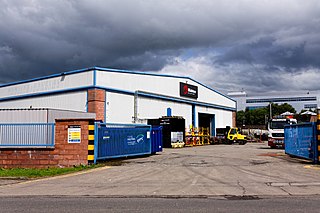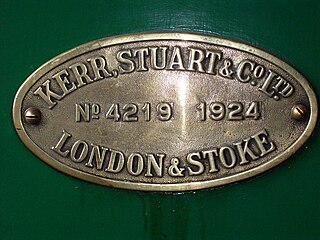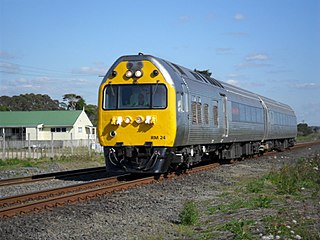
A diesel locomotive is a type of railway locomotive in which the prime mover is a diesel engine. Several types of diesel locomotives have been developed, differing mainly in the means by which mechanical power is conveyed to the driving wheels.
Brush Traction is a manufacturer and maintainer of railway locomotives in Loughborough, England. It is a subsidiary of Wabtec.

The Ganz Works or Ganz was a group of companies operating between 1845 and 1949 in Budapest, Hungary. It was named after Ábrahám Ganz, the founder and the manager of the company. It is probably best known for the manufacture of tramcars, but was also a pioneer in the application of three-phase alternating current to electric railways. Ganz also made ships, bridge steel structures and high-voltage equipment. In the early 20th century the company experienced its heyday, it became the third largest industrial enterprise in Kingdom of Hungary after the Manfréd Weiss Steel and Metal Works and the MÁVAG company. Since 1989, various parts of Ganz have been taken over by other companies.

Andrew Barclay Sons & Co., currently operating as Brodie Engineering, is a builder of steam and later fireless and diesel locomotives. The company's history dates to foundation of an engineering workshop in 1840 in Kilmarnock, Scotland.

Sentinel Waggon Works Ltd was a British company based in Shrewsbury, Shropshire that made steam-powered lorries, railway locomotives, and later, diesel engined lorries, buses and locomotives.

Kerr, Stuart and Company Ltd was a locomotive manufacturer in Stoke-on-Trent, England.

W. G. Bagnall was a locomotive manufacturer from Stafford, England which was founded in 1875 and operated until it was taken over in 1962 by English Electric.

The NZR RM class McEwan Pratt petrol rail motor was the first rail motor to run on New Zealand's national rail network, though it was never used in revenue service. It was built in 1912 at a time when the New Zealand Railways Department (NZR) was seeking alternative methods of providing rural passenger transportation. "Mixed" trains that carried both passengers and freight were typical on country branch lines as there was not sufficient traffic to justify a separate passenger train, but the schedule delays caused by loading and unloading freight during the journey made the mixed trains undesirable.

Clayton Equipment Company Ltd, now known simply as Clayton Equipment Ltd or CEC and CEL, is a locomotive construction company that specialises in rail equipment, design and build, tunnelling, mining, metro, mainline and shunter locomotives.

The Baguley valve gear is a type of steam engine valve gear invented by Ernest E. Baguley, the Chief Draughtsman of the W.G. Bagnall company of locomotive manufacturers and patented in 1893. It was used by Bagnall during Baguley's time there, then by his own company of Baguley Cars Ltd.

The RM class was the classification used by the New Zealand Railways Department (NZR) and its successors gave to most railcars and railbuses that have operated on New Zealand's national rail network. "RM" stands for Rail Motor which was the common name at the turn of the 20th century for what became known in New Zealand as railcars. As many types of railcars are operated, class names have been given to each railcar type to differentiate them from others.
The Drewry Car Co was a railway locomotive and railcar manufacturer and sales organisation from 1906 to 1984. At the start and the end of its life it built its own products, for the rest of the time it sold vehicles manufactured by sub-contractors. It was separate from the lorry-builder, Shelvoke & Drewry, but it is believed that James Sidney Drewry was involved with both companies.

Ernest E. Baguley (1863–1948) was a British engineer.

The Maudslay Motor Company was a British vehicle maker based in Coventry. It was founded in 1902 and continued until 1948 when it was taken over by the Associated Equipment Company (AEC) and along with Crossley Motors the new group was renamed Associated Commercial Vehicles (ACV) Ltd.
The NZR RM class Westinghouse railcar was an experimental railcar built by the New Zealand Railways Department (NZR) in 1914. Although not the first railcar to operate in New Zealand, it was the first to enter revenue service.

Baguley Cars Ltd was a British engineering company, specialising in railway locomotives. it was founded in 1911 by Ernest E. Baguley and subsequently acquired by Drewry Car Co to form Baguley-Drewry in 1964.

Rigid-framed electric locomotives were some of the first generations of electric locomotive design. When these began the traction motors of these early locomotives, particularly with AC motors, were too large and heavy to be mounted directly to the axles and so were carried on the frame. One of the initial simplest wheel arrangements for a mainline electric locomotive, from around 1900, was the 1′C1′ arrangement, in UIC classification.
Walker Brothers Limited was a manufacturer based in Pagefield Ironworks, Wigan, England. It produced ventilation equipment for mining, truck and bus chassis, mobile cranes, and railway locomotives and railcars.

Baguley 774 is one of the earliest surviving narrow-gauge internal combustion locomotives. It was built in 1919 for the Timber Supply Department of the Board of Trade. After a varied career, it was preserved at the Narrow Gauge Railway Museum in Tywyn.
Parsons Engineering Co. Ltd of Town Quay works, Southampton was originally incorporated in 1904 as Parsons Motor Co. Ltd by Mr Harry Parsons (1873-1951). It was advertised both as repairers of Motor Cars, but also as sellers of Motor Boats and engine and propeller sets. Not to be confused with C. A. Parsons and Company who made marine steam turbines.

















